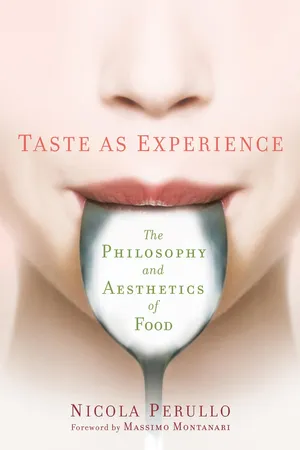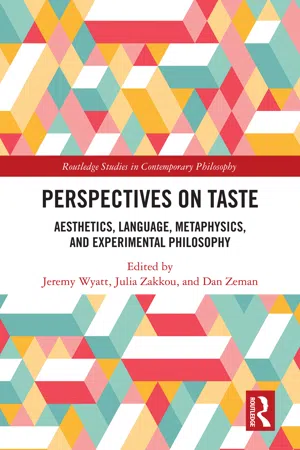Languages & Linguistics
Gustatory Description
Gustatory description refers to the use of language to convey the taste and flavor of food and beverages. It involves the use of sensory vocabulary to articulate the sensory experience of eating and drinking. This type of description is important in culinary writing, food reviews, and sensory marketing to evoke the experience of taste through words.
Written by Perlego with AI-assistance
Related key terms
Related key terms
1 of 4
Related key terms
1 of 3
4 Key excerpts on "Gustatory Description"
- eBook - ePub
Sensing the World
An Anthropology of the Senses
- David Le Breton(Author)
- 2020(Publication Date)
- Routledge(Publisher)
The gustatory is an individual category, hidden in the privacy of judgment, a privilege of the inner self. Tasting isolates individuals in a universe of flavors and pleasures that seem to concern them alone De gustibus non est disputetidum. 1 The taster struggles to find the words to describe bis or her experience. Brillat-Savarin was obliged to invent words to help his readers grasp these nuances. When Alice describes the contents of a little bottle having "a sort of mixed flavour of cherry-tart, custard, pineapple, roast turkey, toffy, and hot buttered toast" (Carroll 2006: 6), she is expressing the largely subjective dimension of flavors that for her are associated with pleasure and peculiarity. Though people's basic experience of food is similar within a particular social group and time period, other epochs have known very different cuisines. Taste preferences are a matter of convention and susceptible to radical change. In French cuisine, the sweet and salty are completely separated, but, in the Middle Ages, and up until the turn of the seventeenth century, meat dishes were often served with sugar or honey. According to William Edward Mead, "Modern [English] taste is so different from that of four or five hundred years ago that scarcely one of the favorite dishes served at feasts would now be found eatable" (1931: 53). Mead's observation would apply to many European societies, especially France, Italy, and Spain, all of which radically broke with medieval culinary traditions. Taste is not a mathematical value but is, rather, discriminating and symbolic, and strictly governed by variations in taste (understood in the moral sense). The literal translation of terms designating different flavors in different societies introduces a large margin of ambiguity - eBook - ePub
Taste as Experience
The Philosophy and Aesthetics of Food
- Nicola Perullo(Author)
- 2016(Publication Date)
- Columbia University Press(Publisher)
It is very telling that some authors have compared this need with a prosthesis that weakens the importance of taste with respect to sight and hearing, those autonomously symbolic and expressive senses (Leroi-Gourhan 1964–65). But now, on the contrary, also from recent cognitive and psychological research, we can see this as an asset: taste always confronts us with a complex multisensory field, so much so that other scholars have even tried to establish correspondences between the gustatory and the visual qualities of a dish. The representational need of taste can be understood both as a mental induction to taste and as its condition of access. For instance, a name or a word may produce—or bypass—the taste of food (the name of the meatballs in Calvino’s story) because words have to do with the mouth. Words and writing condense taste and image into the imaginary, of course without reducing the real meatball to its sound or its description. Taste perception always signals a surplus of the signifier (food “in itself,” while we assimilate it in the concrete relationship) with respect to the signified (its expression and its expressibility). But words and, even more, visual representations have great power. They induce and arouse revulsion and prevent access to certain experiences, as demonstrated by many experiments regarding the conditioning of perception (Taylor 2004; Gueguen 2010). Each verbal or figurative sign refers to a specific horizon of gustatory expectation that activates channels of attention. Chefs are clearly well aware of this, and they sometimes devote much time to the multisensory construction of their dishes, with particular attention not only to appearance, but also to names. Real gustatory experiences possess a regenerative potential for human existence, having to do with a cultivation of the awareness of one’s body and sensitivity. Taste as embodied knowledge can be an effective critical instance for a renewal of deeper experiential modalities - eBook - ePub
Sensory Marketing
Research on the Sensuality of Products
- Aradhna Krishna, Aradhna Krishna(Authors)
- 2011(Publication Date)
- Routledge(Publisher)
Although most of us distinguish clearly among our five senses, for some people this distinction gets muddled so that two or more senses get intermingled. For example, some individuals can see colors when hearing sounds (light colors for high-pitched and dark for low-pitched) and others can actually “taste” words. The latter is called lexical-gustatory synesthesia. Until recently, the belief was that sounds of words trigger tastes so that, for instance, the sounds “eh” and “mmmm” tasted of mint and “aye” tasted of bacon. However, recent findings (Simner & Ward, 2006) indicate that the connection is not phonetically based but lexically (i.e., meaning) based. Simner and Ward (2006) showed individuals pictures of uncommon items so that the sound and form of the word were merely on the tip of the tongue (TOT) but not completely processed, whereas the meaning was fully present. These gustatory synesthetes actually tasted the concept of the word and were accurate with the retest of the taste over a year later, showing that the tastes were not merely constructed on the spot. The concept of synesthesia will continue to receive attention, hopefully furthering our understanding of the multisensory interactions among the senses and better explicating the neural structure of sensation. Conclusions In this chapter we have identified some exciting new research on taste perception and also on consumption. Taste research is still relatively new to marketing. On the other hand, with brands no longer having the cache they once had, food marketers are looking for ways to increase consumer preference for their products. One way to do this may be to make the purchase or consumption experience of food more exciting for the consumer. Although research has focused on the latter, there is little work on the former. While food marketers are trying to make their products more appealing, public policy officials are trying to reduce obesity among consumers and restrain consumption - eBook - ePub
Perspectives on Taste
Aesthetics, Language, Metaphysics, and Experimental Philosophy
- Jeremy Wyatt, Julia Zakkou, Dan Zeman, Jeremy Wyatt, Julia Zakkou, Dan Zeman(Authors)
- 2022(Publication Date)
- Routledge(Publisher)
Part IAestheticsPassage contains an image
2The Trajectory of Gustatory TasteKevin SweeneyDOI: 10.4324/9781003184225-3Gustatory experience, sensing the flavors and other qualities of what one is eating and drinking, often exhibits a vividness that captivates and focuses one’s attention on what appears to be taking place in one’s mouth and on one’s palate. Nevertheless, even though one can acknowledge the forthright presentation of such experience, recent scientific research has proposed that gustatory sensing and focusing on one’s mouth and palate are based on an illusion as to their origin. Yet one still commonly seems convinced that these qualities are experienced as being in one’s mouth. True, there are qualities such as sweet, sour, salty, bitter, and the more recently discovered umami (sometimes referred to as “savory”) that are sensed by taste receptors in one’s mouth. However, most of the flavors that one believes to be in one’s mouth and on one’s palate are produced by olfactory sensing. A commonplace estimate is that 80% of what we sense as gustatory flavors are sensed by smell.1 Specifically, when one breathes out through one’s nose, vaporized molecules produced by ingesting or chewing what one has consumed are drawn and travel up through the nasopharynx at the back of the throat into the top of one’s nasal passages, where they stimulate the olfactory epithelium and the olfactory bulb.In light of this illusion, the project of this chapter is two-fold. First, an exploration of what gave rise to the recognition of this gustatory illusion, sometimes referred to as an “illusion of mislocation.”2 This will involve examining how classical theories of taste were replaced by positing the interdependence of taste and smell. In turn, this led to a recognition of the physiological trajectory involved in coming to sense and experience what we have ingested and consumed. Second, a critical examination of several attempts to short-circuit this trajectorial process and propose that there is a more limited way in which we sense what we have ingested. This abbreviated approach has led to a misunderstanding of the role that the trajectory of ingesting plays in gustatory experience. It has inhibited exploring and understanding some current concerns about what we taste, such as the nature of the qualitative character of a wine’s terroir
Index pages curate the most relevant extracts from our library of academic textbooks. They’ve been created using an in-house natural language model (NLM), each adding context and meaning to key research topics.
Explore more topic indexes
Explore more topic indexes
1 of 6
Explore more topic indexes
1 of 4



